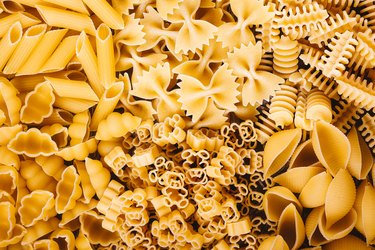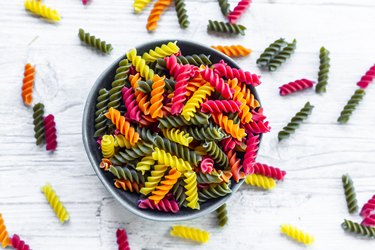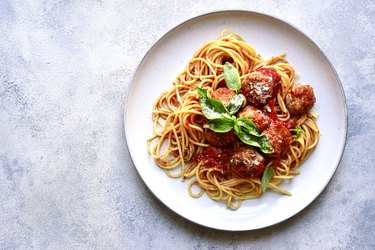
Pasta is one of the world's great comfort foods. You can sauce it in any number of ways, from rich concoctions of cream and cheese to complex Bolognese to something as simple as garlic and olive oil. While pasta itself is relatively straightforward to cook, it's not necessarily easy to get that perfect al dente texture every time. Let's take a quick look at how to cook pasta, and what sorts of things can—and sometimes will!—go wrong.
First...How to Cook Pasta
Video of the Day

Before we delve into the most common pasta problems, it's important to have a basic understanding of how to cook pasta properly. There's a broadly accepted technique that works for most varieties.
Video of the Day
Bring a large pot of water to a boil. (Pasta manufacturer Delallo suggests 5 quarts of water for a pound of pasta, which is fairly typical.) Generously salt water, add pasta, stir and start watching the clock. Begin checking pasta a couple of minutes before the package says it's supposed to be ready. Drain when you bite into pasta and find that it's al dente.
Following these instructions will generally result in a usable pasta dish, but you might have a few questions. How large is a "large pot," for example? Well, it needs to be large enough to hold your 5 quarts of water and should have a few inches of leeway for water to bubble and foam as it boils and the pasta releases its starches.
How Do I Know When My Pasta Is "Al Dente?"
The phrase "al dente" literally means “to the tooth.” All it means is that the pasta is cooked enough to be tender while retaining a degree of firmness. Al dente pasta should still offer a bit of resistance to your teeth. If you fish a piece of half-cooked pasta from the pot and cut or bite into it, you’ll see a white-looking core (or ring, in the case of tubular pasta) where the pasta isn’t yet cooked. The longer your pasta boils, the smaller that uncooked layer gets. It’s al dente when that uncooked core dwindles to a tiny dot in the middle of spaghetti or fusilli. With time and practice, you’ll come to recognize it when you see and taste it.
8 Common Pasta Problems
From overcooked pasta to sauce that doesn't cling to noodles, here are some of the most common pasta issues...and how to solve 'em!
1. "I always cook too much or too little pasta."

THE ISSUE: Anyone who's made pasta knows that it can be challenging to figure out just how much to cook. And most of us have ended up accidentally making enough pasta to serve a hungry family of five when we're really only cooking for two. Never fear: There are some fairly well-established rules to help you decide how much pasta to cook.
THE SOLUTION: Typically, 2 ounces of dried pasta is a good per-person portion as a side dish, so pasta for two takes roughly 1/4 of a 1-pound package. For macaroni and other short shapes, it comes out to about 1 cup per person. If pasta will be your main dish, you can step that up to 3 ounces per person (with a heavy, filling pasta sauce) or even 4 ounces (with a lighter sauce).
2: "I'm not sure how much salt to add when boiling pasta."
THE ISSUE: When it comes to pasta preparation, "salting generously" is a key component. As detailed in our basic pasta cooking instructions above, you'll add salt directly to the water. But what portion of salt constitutes "salting generously"?
THE SOLUTION: Some instructions say to make pasta water "as salty as the sea," but that's far too much. One or two Tbsp. salt in our hypothetical 5 quarts of water should suffice. Your goal isn't to make the pasta actually taste salty—you simply want to season it enough that it won't neutralize sauce flavors.
3. "The pasta is undercooked."

THE ISSUE: Undercooked pasta happens most often when you're still learning what al dente pasta looks and feels like. It's pretty easy to identify: Undercooked pasta will be dry, hard and possibly even a bit crunchy. No, thanks!
THE SOLUTION: If you've erred on the side of caution, you'll just need to cook pasta a bit longer when it's undercooked. But if you've already drained the pasta, add more boiling water—you can finish cooking it easily enough. Alternatively, add sauce and let pasta absorb the remaining moisture it needs. You might need to thin your sauce a little (and pasta cooks more slowly in sauce than it does in water), but it works. As a bonus, your pasta will absorb flavor from sauce. This works for stovetop pasta, but you can also use slightly undercooked pasta in a casserole.
4. "The pasta is overcooked."
THE ISSUE: It's easy to let your pasta cook past its ideal texture if you're distracted by other meal prep (or if you put too much trust in the cooking time shown on the package). Unfortunately, once that happens, there isn't a lot you can do to salvage it.
THE SOLUTION: Your best bet might be to rinse it under cold water to stop further cooking, then let it cool while you prepare a new pot of pasta. As your overcooked pasta cools, it will firm up and might be used successfully in a salad. Alternatively, consider using it in a casserole if you prefer softer pasta.
Tip
Achieving the right texture with whole wheat or gluten-free pasta can be especially challenging because there’s a fine line between undercooked and overcooked noodles. Try several brands and find the one you like best, then cook repeatedly until you determine that perfect balance point between chewy and mushy.
5. "The pasta is unevenly cooked."

THE ISSUE: Unevenly cooked pasta usually happens because it's not stirred enough (the undercooked areas will be where pasta pieces stuck together) or you didn't use enough water to completely cover the pasta. In that instance, undercooked areas will be where the pasta was sticking out of the water for a significant portion of the cooking time.
THE SOLUTION: You can usually fix this by simply keeping pasta hot in its sauce for several minutes. It will continue to cook (slowly!) and absorb moisture, which should even out texture.
6. "My fresh pasta isn't cooking properly."
THE ISSUE: You might face difficulties while cooking with fresh pasta. Fresh and dried pasta—despite their similarities—are two very different products. Dried pasta is made with just water and durum flour (durum is an ancient form of wheat). Fresh pasta, on the other hand, is made from regular all-purpose flour, bread flour or Italian-style "00" flour mixed with eggs.
THE SOLUTION: Homemade fresh pasta needs only a very brief cooking time—typically just a minute or two. If you cook it any longer, it'll quickly become mushy. Store-bought fresh pasta can take slightly longer, but—again—the package cooking time is just a guide. Anytime you cook pasta, fresh or dried, test frequently and trust your judgment rather than the package's recommended cooking time.
7. "The pasta sauce doesn't cling to the noddles."

THE ISSUE: If your pasta and sauce are reluctant to get acquainted, there are a couple of possible explanations. One is that you've added oil to the pot. Despite conventional wisdom, adding oil is a no-no because it lubricates pasta and keeps sauce from clinging. Rinsing your pasta while it's in the colander is the other main error you need to be aware of. This rinses away a layer of starch from the pasta's surface, which would otherwise help sauce cling. You really shouldn't rinse (or oil) pasta unless you're planning to let it cool and use later (for a pasta salad, perhaps).
THE SOLUTION: The best fix for non-clingy pasta is pasta water. Next time, instead of pouring cooking water down the drain, keep back a cup or so. Add pasta to sauce and simmer for a few minutes, adding a splash or two of pasta water every so often. The starch that cooks off the pasta will help bind sauce to noodles and provide a better end result. It's an old Italian trick for better pasta dishes.
Debunking a Few Pasta Myths...
Science-minded food writers have tested many pieces of traditional wisdom regarding pasta and found them lacking. Here are a few debunked pasta myths:
Myth 1: Pasta must be cooked at a rolling boil
You don’t actually need to cook pasta at a rolling boil. You don’t need to boil pasta at all, in fact—a gentle simmer will actually do the trick. So forget about high heat and the corresponding waste of electricity or gas.
Myth 2: Pasta needs lots of water to cook
The traditional advice to cook pasta in plenty of water also doesn’t hold up under testing. Just enough to cover the pasta will do fine. If anything, it’s better to use less: It means your water becomes starchier (and therefore better to use with sauce), and a smaller volume of water is quicker to come back up to temperature.
Myth 3: Pasta noodles should never be presoaked
Part of the reason fresh pasta cooks more quickly than dried pasta is that its starch molecules (which make up most of the carbohydrates in pasta) are already fully hydrated and just need to be cooked. You can speed your cooking time for most types of pasta by soaking noodles in advance to rehydrate them, then finishing them in hot or boiling water.
8. "The pasta sauce isn't creamy enough."
THE ISSUE: There's nothing worse than digging into a fully prepared pasta dish only to discover that you've got a watered-down sauce. Luckily, the key to fantastically creamy pasta is relatively simple.
THE SOLUTION: Again, the solution is pasta water! Some very traditional, classic pasta dishes simply can't be achieved without the use of pasta water. Pesto sauce, for example, is traditionally tossed with pasta and a few splashes of cooking water in order to achieve a creamy, emulsified texture. Classic carbonara, similarly, calls for tossing spaghetti with beaten egg and pasta water to create a perfectly creamy sauce. The same holds true for cacio e pepe, which uses pasta water and Parmesan cheese to create sauce.
By all means, stick with tradition until you're comfortable cooking pasta and can reliably get the result you're looking for. Just remember: When you're prepared to branch out and experiment, you'll find plenty of paths that lead to perfect pasta.